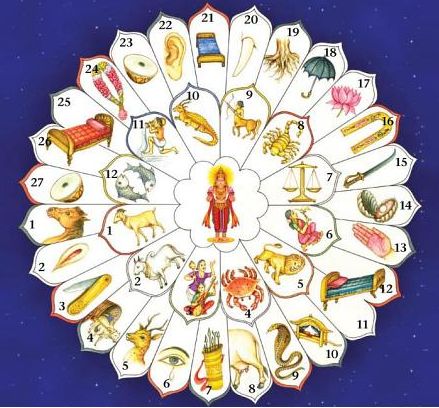The Moon, Lord Chandra, is a well-known figure in Hindu mythology, with striking good looks, almost effeminate, tall, youthful and amorous by nature. He has a likable and friendly persona but is both sensitive and fickle minded and somewhat wild and unpredictable. He is shown wearing fine white garments and silver ornaments. He is known as Lord Chandra, the shining one and Soma, the intoxicating drink of the gods, from which we derive the name of Monday, Somvar. He wears a garland of pearls and rides a chariot seated on a lotus cushion, drawn by a pair of antelopes, befitting the speed with which he traverses the heavens as the fastest ‘planet’, barely pausing in a Sign of the Zodiac for a couple of days. He helps trees and plants grow, is a source of strength for the demigods on account of their supping of the divine nectar, Soma, which he symbolizes.
Legends tell us that he is the son of Varun, lord of the oceans. Other legends tell us that he is son of the sage Atri and his consort Anasuya. The Yadav dynasty of Lord Krishna, the divine incarnation of Vishnu the sustainer of the worlds, claim descent from him, as do several warrior clans, calling themselves the Chandravanshis. Legend also has it that he abducted Tara, the wife of Brihaspati, Jupiter, the guru of the demigods and she begot his son Buddh, Mercury. A popular legend speaks of his marriage to the 27 daughters of the administrator of the temporal cosmos, Daksh Prajapati but his obsessive devotion to only one of them Rohini, to the complete neglect of the others upset Daksha. The 27 symbolize the star clusters (Asterisms) within the Zodiac, also called the Lunar Mansions, the Nakshatras. The moon inhabits one each day of the lunar month. The legend goes that thus angered the intemperate Daksha cursed the Moon, afflicting him with leprosy. The Moon pleaded with  Lord Shiva to undo the curse. After much penance Shiva allowed a modification of the curse. Thereafter he was to experience a diminishing of his glow for half the month and a revival in the other half till he attained his former glory during Purnima, the full moon day. The moon also adorns the hair lock of Lord Shiva to keep him cool after he drank the pot of poison which emerged from the churning of the cosmic oceans, to save the world from apocalypse.
Lord Shiva to undo the curse. After much penance Shiva allowed a modification of the curse. Thereafter he was to experience a diminishing of his glow for half the month and a revival in the other half till he attained his former glory during Purnima, the full moon day. The moon also adorns the hair lock of Lord Shiva to keep him cool after he drank the pot of poison which emerged from the churning of the cosmic oceans, to save the world from apocalypse.
Quite aside from the myths and legends the Moon occupies a predominant position in the lives of Hindus as the single most important ‘planet’. The Hindu calendar for millenia has been lunar not solar. Days of the week are determined by the position of the Moon in the Nakshatras and the month is defined by its waxing and waning phases. Auspicious and inauspicious moments arise from the status of the Moon. For Hindus it is their true chronometer and also the harbinger of good and evil events. But it is much more than a device to track time. It has been given a central place in astrology because of Vedic presumptions. It is regarded as a significator of the mind and emotions as the Sun is the significator of the Soul. The state of the mind governed by the Moon becomes the key element in determining the life of man.
The Moon governs the manner of determining days and months in a year. We therefore have a lunar day ( Tithi ), a lunar month and a lunar year, lunar birthdays and natal charts. Among Hindus it is not the solar birth Sign ( the Zodiac Sign in which the Sun was at the time of a birth) but the Zodiac Sign which was on the horizon at the time of birth that determines the birth Sign assigned to a person. For instance my solar birth sign is Sagittarius but the birth Sign for my natal chart is Cancer. We have already seen that there are 27 Nakshatras or star clusters within the 12 Signs of the Zodiac, 2 1/4 for each. Hindu astrology, Jyotish, gives you your precise Nakshatra at birth ( the Nakshatra in which the Moon was at the time of your birth ), which determines your likely personality and inclinations. The placement of the Moon at birth also determines the planetary cycles of life, the Dashas, which are central to predicting events in one’s life in Jyotish.
The Moon in the ascendant phase is a benefic planet for the subjects chart and in the waning phase at the time of birth is malefic. The moon is lord of Cancer and like the Sun owns only one Zodiac Sign. It is exalted in Taurus and debilitated in Scorpio. It is friendly to the Sun and Mercury, neutral to others and inimical to none. This ‘relationship’ between planets assumes significance when studying the natal chart. For instance when two planets are in ‘opposite’ Houses of the chart in astrological terms they are said to ‘aspect’ or influence each other. Their relationship then comes into play for predictions.
The Moon is significator of the mind, intellect, temperament, mother, meritorious Karma from previous lives, beauty, complexion, attractiveness, para-psychological abilities and love of pleasure. On the negative side it is significator of lunacy, addictions, jaundice, epilepsy and lethargy. Physically it represents the mind, chest, breasts and limbs.



0 Comments